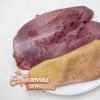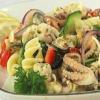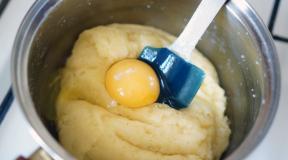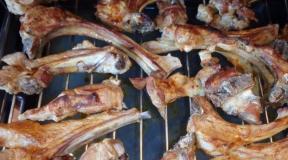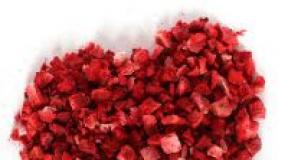Unusual sushi and rolls. Which rolls are the most delicious - photos and names, reviews
The cooking process does not take much time, and the result will please the home and pleasantly surprise the guests. Recipes for sushi and rolls are very diverse, and everyone will find what they like. You can cook this exotic culinary masterpiece from fish, meat, shrimp, squid, crab sticks, canned food and greens, combined with rice, which is placed inside. It serves as a binding ingredient and due to it the finished dish retains its shape.
The five most commonly used ingredients in recipes are:
For vegetarians, there are many options with vegetables and fruits that taste just as good as fish products. The secret of the unique aroma of this dish lies in the algae, in which the roll is wrapped. And in the traditional combination with soy sauce and wasabi, this treat will not leave anyone indifferent. Among the recipes there are many options for baking. They are prepared in much the same way as ordinary sushi and rolls, but at the end they are filled with sauce and briefly sent to the oven, which gives an amazing flavor. Such food is served for a regular family dinner and for a festive table.
Just recently, one of the federal channels showed a story about a small virtual community opposing well-known Japanese dishes - for example, sushi and rolls. Its participants told some sheer tales about allergies to certain ingredients of dishes, the use of terrible additives, the wrong combinations of ingredients, and even serious risks when consuming rolls more than 1-2 times a month.
In addition, the ideologists of "anti-sushi" intend to use propaganda to achieve a serious decrease in the popularity of such food in Russia. And this despite the fact that fans of Japanese cuisine consider their opponents to be obscurantists who do not understand absolutely anything either in cooking or in dietetics. Everything is quite complicated, and, in general, real hostilities unfolded on the “fronts of rice and fish”.
But we will not figure out who is right and who is wrong, but we will only try to figure out what “running” and little-known rolls are. And why they remain or become so.
Rolls - "stars"
Brief excursion. It is believed that rolls (in a form remotely familiar to us) appeared in Southeast Asia and China about two thousand years ago. Nori then, of course, no one used - everything was limited to unseasoned rice and pieces of fish.
But the Japanese already “formalized” the whole thing (after about one and a half thousand years), naming the creation of rice, a plate of algae and fish and vegetable filling with the complex word makizushi. Actually, this is how they should be called now: makizushi are rolls “in principle”. They are divided into complex (rice on top) - uramaki, and simple (nori on top) - hosomaki.
It was in this format that makizushi rolls spread around the world, becoming in fact a part of fast food, occupying its more “healthy” and harmonious taste niche than the super-popular pizzas, burgers and hot dogs. But some “samples” today can easily measure their popularity even with the legendary Big Macs and pepperoni pizza - this especially applies to three types of uramaki rolls and one “canonical” hosomaki roll:
"Philadelphia"

As many of you probably already know, all the complex rolls with “geographical” names indicated here have nothing to do with classic Japanese cuisine.
And the Philadelphia roll is “ahead of the rest”, because it is believed to be named only after the cheese of the same name (it is always added inside) and was invented almost by accident - somewhere in the depths of the American continent.
The reason for the popularity of such a roll is quite understandable - it's all about the surprisingly pleasant taste balance of red fish and cream cheese (it will be winning in any dish). If you want to evaluate something similar, go to the site japonchik.ru/rolly - there, in the "classic rolls" section, you will find the very "correct Philadelphia".
"California"
But this roll, according to experts in the field of such cooking, was really invented in the state of California. Its recipe (as well as the taste) is as simple as possible - imitation crab and cucumber slices are wrapped in rice with nori, everything is decorated with tobiko caviar on top.
Probably, its simplicity is also due to its widest distribution. Many "eaters" love it very much, but it is believed that the prices for this roll are usually very high.
"Canada"
Any stories about the origin of such a "state" name cannot be considered unambiguously reliable. Moreover, the composition of this roll cannot even be remotely connected with the country of the “maple leaf”.
But it does not matter that sushi chefs consider the name of the Canada roll to be fantasy, the main thing is that it is very tasty. After all, its filling includes cream cheese, salmon, cucumber / avocado and, of course, smoked eel, which “gives out” a very pleasant, slightly sweet and smoky flavor.
Shake maki
This is just that “loner” from the category “hosomaki rolls”. And everyone, for sure, is well familiar with the “baby” from a nori sheet, a small amount of rice and a few “bars” of salmon (another red fish).
The most interesting thing about all this is that such a roll will actually be served to you in any relevant institution in Japan. In fact, shake maki is the basis of every "sane" roll menu. Without it, nowhere.
A bit of "exotic"

As for unusual rolls, this, of course, is already an absolutely author's cuisine, which only exploits certain Japanese "motives". You will not be able to taste something like this in every sushi bar. In addition, many "exotic rolls" meet the requirements and formats of the area where they are prepared.
All this is not classifiable. We can only single out two conceptual approaches to creating such an "unusual" when preparing rolls:
- Use of unexpected ingredients. This is how “Shaurma Roll” (from chicken, greens and special sauce) and even “Roll Herring under a fur coat” are obtained.
The essence is clear - something regional, understandable for the population is used as a filling (they say that rolls with ordinary cheese, not soft cheese, are gaining popularity in Italy), or something completely unexpected. For example, meat (bacon), fruits, vegetables, any processed foods or canned food.
The Japanese consider sushi (sushi) a healthy food and eat it along with, for example, soup, as an addition to it. However, the popularity of this dish is so high all over the world that a lot of new, diverse and creative things have been introduced into the preparation of sushi, including the invention of rolls.
In the form that we see today, sushi was invented by Yohei Hanai around 1820. The sushi was called nigiri. Sushi itself was previously written with the hieroglyph "fish", today it is translated as "style of behavior" or "longevity", which carries respect for this dish.
More than 30 years ago, at the dawn of the popularity of sushi in the United States, they were more popular than Coca-Cola, the portions were twice as large, and for the freshness of the fish, the cooks marinated it in soy sauce or vinegar, or salted it.
Not so long ago, it took 10 years to become a sushi chef. However, nowadays chefs take 2 years to cook rice and 3 years to cook fish.
The most popular and sold roll in Russia, and indeed the most popular Japanese dish, is the California roll. The roll was first invented not in Japan, but in the USA. Noting that it was unusual for customers to see nori leaves on the outside, chef Ichiro Mashita, who worked in Los Angeles, rolled nori leaves with filling (crab, avocado, cucumber) inside, made rice on top and sprinkled with caviar.
Sushi cake is a modern popular dish
California roll refers to uramaki rolls - made "inside out".
Today, sushi makers surprise not only with a variety of fillings, but also with the look and design of sushi. For example, Takyo Kiyota from Tokyo knows that cooking stuffed rice rolls is a real art, where the flight of fancy can be simply limitless.
She makes a variety of sushi that look like regular sushi on the outside but always have different designs on the inside. The craftswoman herself admits that she always worries about what will happen, because one careless pressing can lead to a shift in rice and the drawing will not work out. By the way, the Japanese prefer a man to make sushi, they say women have a higher body temperature and sushi is not so tasty.
Today, the most popular topping in sushi is tuna, with nearly 80% of the world's supply of bluefin tuna going to sushi restaurants. In 2010, the most expensive tuna weighing 232 kg was sold in Tokyo for 122,000 euros.
Bread, egg, carrot, beetroot, mashed potatoes, compote
Considering the creative approach to sushi, we also note the Lithuanian art studio Clinic 212, which beat the situation of the popularity of sushi in a funny art project Eastern European Sushi.
Humorous designers made the usual rolls from products unusual for sushi: bacon with garlic, herring, sprat, chicken breast, boiled pork, instead of shrimp - sausage and cheese, instead of rice - potatoes, dough, jelly, as well as an egg, green onion, boiled vegetables and much more, so uncharacteristic of Japanese cuisine.
Onion, horseradish, bread, lard, vodka
Cucumber, bread, sausage, mustard, ketchup
The sauces are also curious - here are exclusively proven and native sunflower oil, vinegar, ketchup, mayonnaise, as well as homemade sauces.
Cutlet, pickled cucumber, puree, radish, sour cream
Glowing Sushi, glow-in-the-dark sushi made from GMO fish, has become a true culinary sensation in US restaurants.
This amazing dish uses GloFish, a special breed of fish, genetically bred to indicate the purity of the water. The fish glows brighter the higher the pollution level. These fluorescent fish have gained popularity and have appeared in pet stores as well as nutrition.
A dish with these fish does not undergo heat treatment - the fish are frozen, and after that they protect the ability to emit different colors (purple, blue, yellow) in the dark. Sushi with these fish has become very popular.
Insect sushi is the latest in sushi, but the truth is, few people are willing to try it. According to polls, 50% of respondents consider them disgusting.
Another fact from the world of fillings is that yellowtail, which is very popular as a filling for rolls and is valued for its very fatty meat, is specially fattened until the muscles atrophy so that it does not move and becomes fat.
Among the rolls there is also an interesting variety called "temaki" - in the form of a nori cone with stuffing inside. . Translated from Japanese, it means “rolls that are formed in the hands” - they are eaten immediately after cooking, otherwise they will lose their shape very quickly.
Twenty years ago, we associated Japan with animated cartoons, ninjas, samurai, kimonos, etc. Few people knew about the existence of Japanese cuisine. The customers of the first sushi restaurants were the Japanese themselves, who, by the will of fate, ended up in Russia in the early 90s.
Gradually, the fashion for them began to conquer the capital. Each of us can remember the moment when for the first time in his life he took chopsticks instead of a fork and tasted raw fish. And now we have chosen the best sushi in Moscow by comparing bars, restaurants and cafes.
Our selection of the best sushi is determined by the following:
- taste– only the best sushi can be called delicious;
- service- in the best institution "the client is always right", and if he is wrong, then this is not his problem;
- price- expensive does not mean quality at all, so we will select the best sushi in Moscow based on their affordability.
The most popular dishes on the menu of a bar or restaurant, without which no bill can do, are rolls and sushi. It is from them that we will begin to find out where the best sushi is cooked and served in the city. We determined taste and service empirically, i.e. having tried many different dishes in many different places.
Taste is a subjective concept, "there are no comrades." But the service can be unambiguously characterized by such data as: the speed of service, the behavior and attitude of staff towards guests, cleanliness and convenience.
The average score is an important criterion when choosing sushi. For some, it is important to eat tasty food on a small budget, while for others, a solid bill from the most expensive restaurant in Moscow becomes a reason for pride.
To determine the pricing policy of the selected places, the site team added up the prices from the menu and divided by the number of positions. As a result, we got the average cost of rolls for several restaurants. We applied the same formula to calculate the cost of sushi.
Price comparison of five restaurants
| Two sticks | Gin no Taki | Yakitoriya | Niyama | tanuki | |
| Wed cold roll price | 344 | 332 | 331 | 315 | 306 |
| Types of cold rolls | 23 | 25 | 37 | 39 | 45 |
| Wed price of warm rolls | 330 | 408 | 310 | 293 | 384 |
| Types of warm rolls | 7 | 9 | 10 | 9 | 8 |
| Wed sushi price | 98 | 110 | 100 | 89 | 99 |
| Types of sushi | 27 | 19 | 29 | 24 | 24 |
No. 5. Restaurant Two sticks

In the rating “Best Sushi in Moscow”, the chain “Two sticks” has moved from third place to fifth and, if it goes on like this, it will leave it altogether. The interior of the institution is made in urban style. The halls are equipped with monitors, which usually display online scoreboards of Moscow airports.
Japanese, Italian, Pan-Asian, American cuisines are presented here. Every year the quality and service of the institution are falling. The scenario of Two sticks is very similar to the fate of Yaposha. In the same way, the service first fell, and then the quality of the dishes.
By the way, Two Sticks, to put it mildly, has a terribly inconvenient site from all the participants in the rating. The developers tried their best to complicate the life of their customers. Perhaps this was done so that the user did not notice the extra charge on the delivery menu.
Service
If earlier a feature of Two Sticks could be called a strong difference in service in different establishments (there were places where the service and the attitude of waiters were at a very high level, and there were those where they would take an order only ten minutes after your arrival and bring the bill only fifteen minutes later as you requested). Now, most establishments are getting equally bad.
Taste
The quality and taste of dishes in most Two sticks on the same level is normal. We didn't find any dishes that taste so great that we would go to Two sticks for that, but these are normal, acceptable dishes. Gradually, the quality of the food also deteriorates.

Price
On the delivery menu, Two sticks made an extra charge of about 20-40 r, but delivery is free (although it is free for everyone). There are 23 types of cold rolls, 8 warm rolls and 27 sushi rolls. The average cost of cold rolls is 344 r, warm - 384. Cold rolls are the most expensive in the ranking. Sushi cost 98 r apiece.
Menu excerpt
California roll (crab meat, avocado, cucumber, tobiko caviar, rice, sesame) - 360 r
Philadelphia with smoked salmon (hot smoked salmon, cream cheese, rice, cucumber) – 340 r
No. 4 Tanuki Restaurant

On the fourth line of the Way2day rating "The best sushi in Moscow" was the network of restaurants "Tanuki". More than 50 establishments are located throughout Moscow. The pleasant interior of most establishments allows you to dine together or gather friends for a small holiday.
There are solid wooden sofas with soft capes. The tables are separated by decorative partitions, which is very convenient. Not everyone likes to be an involuntary listener to someone else's conversation. Despite the fourth position, Tanuki has the most convenient and pleasant site among our participants.
Service
Visitors are waiting for a small gift from the institution - a cup of red tea "karkade". It is poured from a teapot with a meter spout. The drink quenches thirst well and increases appetite. Waiters and hostesses are unobtrusive and unhurried. If you are very late, then lunch at the Tanuki may disappoint you.
Taste
Dishes have a decent standard taste, no surprises. The rolls are rolled tightly and neatly. Rice is cooked strictly according to the recipe. If you order the most popular items from the menu, then all products will be fresh. Soy sauce is salty and ginger is spicy.

Price
The menu features 42 types of cold rolls, 7 warm and 23 types of sushi. Having carefully studied the menu, we calculated that the average price of cold rolls is 302 r, warm - 330 r and 101 r - sushi.
Menu excerpt
Syake California (with salmon, avocado, cucumber, rice and tobiko caviar) – 360 r
Philadelphia (with salmon, cucumber, avocado, rice and soft cheese) - 395 r
No. 3. Restaurant Gin-no Taki

Gin no Taki moved up to third place from second in our ranking. One of the oldest Japanese restaurants in Moscow. The interior design is designed in a traditional style. The largest tables are only for 6 people. To comfortably accommodate a company of 8 or more people, you need to ask the waiters to move tables of different heights.
Service
Unfortunately, the service in the institution is not improving, but only getting worse. The waiters are not only not fast, but sometimes they completely forget or confuse your order.
Taste
The food as well as the service starts to deteriorate. Some dishes do not match the photos from the menu, but for the most part they are still cooked truly Japanese and delicious. The fish is fresh. The products are selected very carefully. Real pleasure can be obtained from the design of sets, which can please even incredibly demanding visitors. "Gin no Taki" descends to the third line of the "Best Sushi in Moscow" rating.

Price
25 types of cold rolls, 9 - warm and 19 - sushi. The average price of cold rolls is 332 r, warm - 408 (the most expensive of the rating). Sushi cost about 110 r per piece, which is also clearly more expensive than all the other places in the ranking.
Menu excerpt
California with salmon (salmon, rice, cucumber) - 375 r
Philadelphia (salmon, avocado, cream cheese rice) - 449 r
No. 2. Restaurant Niyama

From first place, Niyama descends to second. A network of establishments (21) located throughout Moscow and other cities. The restaurant management is working not only on the interior, but also on the entrance group, so that guests from the sidewalk to the table are met only by high-class finishes and crystal clearness. A sincerely friendly hostess greets you at the entrance and always offers the best free tables, regardless of the number of guests. Here you can taste the best sushi in town.
All establishments of the network have a unique design interior. Waterfalls, living greenery, soft sofas and spaciousness create a light, relaxed atmosphere. The distances between the tables are large and the conversation at one table does not interfere with guests at another at all.
Service
Waiters take orders quickly and accurately. Any wishes on the composition of products in dishes are carried out unmistakably. With rare exceptions (applies to 1-2 establishments, where, unfortunately, nothing changes for the better), the administrators are extremely friendly and welcoming.
It's nice that guests are seated at the tables they like, and not at those where a larger company can be accommodated and the restaurant will receive more profit from them. Unfortunately, there were cases of poor service, and in some places even completely indifferent, but in general, everything is on the level.
Taste
Ready meals and drinks are served in a timely manner: hot - hot, cold - cold. A huge selection of dishes will allow everyone to find their own. The appearance and taste of rolls in Niyama is amazing. Only fresh ingredients are used.
They are well-chosen for each roll or sushi. Good fish, rice, seaweed and other goodies are combined in the right proportions. It's good to see that the soy sauce is not diluted here - it's really thick and not diluted.
We found a dish for which we used to choose Niyama among all establishments - Syake Sandochi. You can try it both in the regular menu and in a business lunch. In just one establishment, we encountered poor quality of manufacturing of these rolls (moreover, on an ongoing basis). But now, we recommend trying a similar dish (Persona Grata) in Yakitoria - it is much better there.
The layer of Tempura on hot rolls is thin and allows you to enjoy the excellent taste of the filling, rather than fried dough. The only drawback is that the rolls are thickly sliced. Not everyone can eat one at a time.
The portion size is impressive, so when ordering a lot, count on your strength. And if, nevertheless, something remains, then the waiters themselves offer to wrap everything with them with pleasure. This does not infringe on the dignity of the guests, but on the contrary, emphasizes the quality and taste of dishes that cannot be left.
Unfortunately, some establishments of the chain provide mediocre service and food on a regular basis. Perhaps the reason lies in the savings on ingredients, and maybe in the staff of a particular place. But it is worth considering that in restaurants at the following addresses: Moscow, Izmailovskoye sh., 69g, Albatros shopping center and st. Snezhnaya, 16, building 6 ... you need to be extremely vigilant when ordering dishes, stock up on time and not pay attention to the rudeness of the staff.

Price
Niyama has 39 types of cold rolls, 9 warm rolls and 24 sushi rolls. The average price of cold rolls is 315 r, which is almost the lowest price in our top five. Warm rolls are the cheapest in our TOP 293 rub.
Sushi costs about 89 r, and according to this indicator, Niyama, among other things, is at the lowest price level from our rating. 10% discount is available for orders placed 6 hours before delivery or pickup. Niyama deservedly takes first place in the "Best Sushi in Moscow" rating and we hope that the franchise will not spoil this network.
Menu excerpt
Syake california (salmon, tobiko, cucumber, avocado, rice) – 325 r
Philadelphia (salmon, avocado, cheese and rice) - 395 r
No. 1. Restaurant Yakitoriya

Previously, Yakitoriya was ranked 5th in the ranking of the best sushi in Moscow according to the site, but recently the owners have significantly increased the quality of food, assortment and service, and Yakitoriya has moved to 2nd place. Now, it surpasses all other networks, including delivery. It is gratifying that regardless of whether you come with discount coupons or without, you equally get decent service and food.
Almost 100 institutions in Russia and the CIS. The interior is made in classic Japanese style. If you are going to a large company, then the tables can be connected and everyone can fit. In the presence of both soft sofas and ordinary wooden chairs.
Service
In recent months, service in Yakitoria has risen significantly. I don't know what it is, but it's great. If earlier there was a noticeable difference between establishments (somewhere they serve quickly, somewhere very slowly), now you hardly notice it. In most places, the service has risen, but it is worth noting that there are still cases of unsatisfactory service, but they have become significantly less.
Taste
Excellent cuisine and excellent taste. Here you can have a good meal at a business lunch and have a good time in the evening with your loved ones. The introduction of new dishes to the menu had a positive effect on the impression of Yakitori. We highly recommend trying the hot roll (if you like them) Persona grata with a special sauce.

Price
The menu offers 37 types of cold rolls, 10 warm rolls and 29 types of sushi. Prices in Yakitoria are reasonable - the average price of rolls is 331 r for cold, 310 for warm and 100 r for sushi.
Menu excerpt
Syake California (salmon, cucumber, avocado, rice, tobiko caviar) – 389 r
Philadelphia (salmon, cucumber, cream cheese, tobiko, rice, green onion) - 417 r
Choose your restaurant Yakitoriya
- images of cartoon characters and superheroes. Or rolls in the form of an aquarium in which miniature fish “swim”. Rolls are made even in the form of a globe.
However, you yourself, with a certain skill and patience, can create. Here are some of the "recipes".
The largest roll with a diameter of 52 centimeters and a width of 80 centimeters was prepared by our compatriots from Yekaterinburg. His weight was about 100 kilograms. The smallest roll was also prepared in Russia in the city of Tver from one grain of rice and a microscopic piece of salmon, its length is only 6 mm!
Flower
Preparing rolls in the shape of a flower is quite simple. To do this, make 5-7 small rolls stuffed, for example, with rice and caviar. They become petals. Small rolls are wrapped in one large roll. As a receptacle (middle of a flower), you can use cucumber, avocado. In Japan, such rolls are called Hana-Zushi -.
Crab

Rolls with a crab pattern on the cut or Kazari sushi can also be made independently. To create crab legs, thin layers of fish wrapped in noria are used. The body can be made from crab sticks, eyes from carrots, and claws cut from fresh cucumber. The main thing is to correctly arrange the prepared individual parts on a rice basis, so that when forming the roll, you get a crab.
ladybug

Rolls with the image of ladybugs will appeal to children. For cooking, you will need to make two semicircular rolls stuffed with rice and red caviar using a bamboo rug. They will represent the wings. And one small round rice roll will be the head. Then these parts are combined into one large roll. By cutting it, you can get several ladybugs. To give the final resemblance, cover the “heads” with nori leaves, cut specks for the wings from them.







